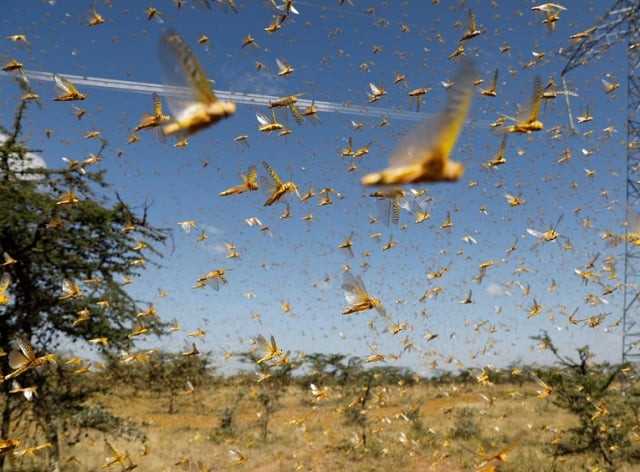Locust catching, value addition – the way forward
Rural community must be trained in locust drying and processing

Locusts have been attacking crops and other green vegetation all over Pakistan for the past over one year and it is predicted that they will stay in the country for the next couple of years.
Traditional locust control techniques include aerial and ground spraying of various toxic chemicals, however, the aerial spray is mostly done in desert areas not only because of low flight safety but also limited residual effects of chemicals. Locusts were mostly confined to deserts last year and, therefore, the Department of Plant Protection (DPP) and provincial agricultural departments resorted to aerial spray without any problems. Early this year in January, locusts entered the agricultural fields in Punjab, eating crops and posing challenges to the biodiversity-rich ecosystem from increased residual impact of chemicals.
In addition to that, due to increased cover of trees and elevated electric transmission and distribution lines, aerial flights were almost impossible in the agricultural fields. Therefore, Pakistan may face food insecurity and greater exposure to the residual impact of toxic chemicals.
Pakistan has ratified several chemical conventions like the Persistent Organic Pollutants Convention, Prior Informed Consent Convention, Basal Convention on Hazardous Waste, and Montreal Convention on Ozone Depleting Substances and is, therefore, obliged to enforce these conventions. The state of affairs necessitates the need for adopting innovative and out-of-box solutions to tackle the challenge.
To cope with the situation, an innovative approach involving community-based locust harvesting was successfully adopted at Depalpur in Okara district in February 2020. The slogan was “Catch locust, earn money and protect crops”.
The community response was overwhelming as it collected tons of locusts in a single night. The locust catch was tested for protein content, which was estimated at 76%, besides many other useful nutrients and vitamins.
Therefore, locusts can be used as a rich source of poultry, fish and other animal feed. Rural community can easily catch locusts to meet its animal feed needs, besides selling them to commercial animal feed mills. Catching and drying locusts for making animal feed is very easy. The federal cabinet, in its meeting held in early June this year, appreciated the model and approved a proposal for catching locusts as a source of protein for animal feed by the communities with a price tag of Rs15 per kg.
Bio-fertiliser
To implement the cabinet decision, the Pakistan Agricultural Research Council (PARC), Ministry of National Food Security and Research has developed a project, aimed at buying locusts from the rural community and their processing to produce bio-fertiliser.
This way, locusts will be used as bio-waste instead of a rich source of protein for making poultry or any other feed. The reason for using the locust catch as a source of compost or bio-fertiliser instead of protein is the difficulty in establishing a feed chain under the market mechanism, as highlighted by project proponents. Consequently, the proposed project will miss the opportunity of using locusts as a valuable source of protein and reducing imports of soybean. The rural community can still use the locusts it catches as a source of feed for the poultry, livestock, fish and pets in their courtyards by following different methods.
How to catch locusts?
Catching locusts is considered a challenge but, in fact, it is the easiest thing to do once you know the locust behaviour. Adult locusts assemble in groups with sunset on trees, in open ground and areas with dense vegetation, and stay there almost motion-less till sunrise the next day. During this period of time, the locusts can be easily catched and stored in any type of bags, preferably aerated plastic mesh bags, allowing transport of live locusts for processing.
During the trial in Depalpur, the community understood the locust catching method so easily that it was able to catch tons of locusts in a single night. The drive continued for three days and it netted tons of locusts for a price of Rs20 per kg.
Drying, processing
The collected locusts should be spread thinly in an aerated yard under partial shade for drying. Locust drying is not much different from drying grains in rural areas. Moisture content should be observed regularly and as their texture appears brittle and dried, locusts should be powdered or stored in small pieces, and can be used as chicken, fish or other animal feed either as such or after mixing with other feed.
This way, the rural community can get benefit from locusts as a source of feed and can compensate for the losses to their crops in some way.
Way forward
With a view to encouraging the local community to catch locusts for its own use and for earning cash, the following way forward is proposed:
Train and educate the local community about locust catching in its vicinity; train the community in drying, processing and value addition; offer locust buyback guarantee; support and encourage private poultry and animal meal enterprises to buy locusts from the rural community; and stop chemical spray in areas where community locust collection is being done.
The writer is a PhD in natural resources management and is a civil servant
Published in The Express Tribune, July 27th, 2020.
Like Business on Facebook, follow @TribuneBiz on Twitter to stay informed and join in the conversation.



















COMMENTS
Comments are moderated and generally will be posted if they are on-topic and not abusive.
For more information, please see our Comments FAQ